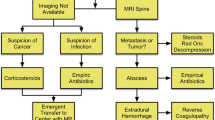Abstract
There are many causes of acute myelopathy including multiple sclerosis, systemic disease (SD), and acute spinal cord compression (SCC). SCC should be among the first potential causes considered given the significant permanent loss of neurologic function commonly associated with SCC. This impairment can occur over a short period of time, and may be avoided through rapid and acute surgical intervention. Patients with SCC typically present with a combination of motor and sensory dysfunction that has a distribution referable to a spinal level. Bowel and bladder dysfunction and neck or back pain may also be part of the clinical presentation, but are not uniformly present. Because interventions are critically time-sensitive, the recognition and treatment of SCC was chosen as an ENLS protocol.

Similar content being viewed by others
References
Vazquez RG, Sedes PR, Fariña MM, Marques AM, Velasco MEF. Respiratory management in the patient with spinal cord injury. BioMed Res Int. 2013;2013:168757.
Wuersmer L, Chester HH, Chiodo AE, et al. Spinal cord injury medicine. 2 acute care management of traumatic and nontraumatic injury. Arch Phys Med Rehabil. 2007;88(3 Suppl 1):S55–61.
Schmidt RD, Markovchick V. Nontraumatic spinal cord compression. J Emerg Med. 1992;10:189–99.
Bammer R, Fazekas F. Diffusion imaging of the human spinal cord and the vertebral column. Top Magn Reson Imaging. 2003;14:461–76.
Levack P, Graham J, Collie D, et al. Don’t Wait for a sensory level—listen to the symptoms: a prospective audit of the delays in diagnosis of malignant cord compression. Clin Oncol. 2002;14:472–80.
Gilbert RW, Kim JH, Posner JB. Epidural spinal cord compression from metastatic tumor: diagnosis and treatment. Ann Neurol. 1978;3:40–51.
Helwig-Larsen S, Sorensen PS. Symptoms and signs in metastatic spinal cord compression : a study of progression between first symptom until diagnosis in 153 patients. Eur J Cancer. 1994;30A:396–8.
Fleming C, Baker JF, O’Neill SC, Rowan FE, Byrne DP, Synnott K. The Oswestry Spinal Risk index(OSRI) : an external validation study. Eur Spine J. 2014. doi:10.1007/s00586-014-3730-z.
Husband DJ. Malignant spinal cord compression: prospective studies of delays in referral and treatment. BMJ. 1998;317:18–21.
Kimo P, Thompson CJ, Kestle JRW, et al. A meta-analysis of surgery versus conventional radiotherapy for the treatment of metastatic epidural spinal disease. Neuro-oncology. 2005;7:64–76.
Bach F, Larsen BH, Rhode K, et al. Metastatic spinal cord compression. Occurrence, symptoms, clinical presentations and prognosis in 398 patients with spinal cord compression. Acta Neurochirugica. 1990;107(1–2):37–43.
Schiff D, O’Neill BP. Intramedullary spinal cord metastases, clinical features and treatment outcome. Neurology. 1996;47:906–12.
Mut M, Schiff D, Shaffrey ME. Metastasis to nervous system: spinal epidural and intramedullary metastases. J Neuro Oncol. 2005;75:43–56.
Sundaresan N, Sachdev VP, Holland JF, et al. Surgical treatment of spinal cord compression from epidural metastases. J Clin Oncol. 1995;12:2330–5.
Burch PA, Grossman SA. Treatment of epidural cord compression from Hodgkin’s disease with chemotherapy. A report of two cases and a review of the literature. Am J Med. 1988;84:555–8.
Boogerd W, van der Sande JJ, Kroger R, et al. Effective systemic therapy for spinal epidural metastases from Breast carcinoma. Eur J Clin Oncol. 1989;25:149–53.
Chen YJ, Chang GC, Yang TY, et al. Surgical results of metastatic spinal cord compression secondary to non-small cell lung cancer. Spine. 2007;32(15):E413–8.
Patchell RA, Tibbs PA, Regine WF, et al. Direct decompressive surgical resection in the treatment of spinal cord compression caused by metastatic cancer: a randomized trial. Lancet. 2005;366(9486):643–8.
Mannion RJ, Wilby M, Godward S, et al. The surgical management of metastatic spinal disease: prospective assessment and long-term follow up. Br J Neurosurg. 2007;21(6):593–8.
Zairi F, Arikat A, Allaoui M, Marinho P, Assaker R. Minimally invasive decompression and stabilization for the management of thoracolumbar spine metastasis. J Neurosurg Spine. 2012;17:19–23.
Walji N, Chan AK, Peake DR. Common acute oncological emergencies: diagnosis, investigation and management. Postgrad Med J. 2008;84:418–27.
Delattre J, Arbit E, Rosenblum MK, et al. High dose versus low dose dexamethasone in experimental epidural spinal cord compression. Neurosurgery. 1988;22(6):1005–7.
Sorensen PS, Helweg-Larsen S, Mouridsen H, et al. Effect of high dose dexamethasone in carcinomatous metastatic spinal cord compression treated with radiotherapy: a randomized trial. Eur J Cancer. 1994;30A:22–7.
Loblaw DA, Perry J, Chambers A, Laperriere N. Systematic review of the diagnosis and management of malignant extradural spinal cord compression: the Cancer Care Ontario Practice Guidelines Initiative’s Neuro- Oncology Disease Group. J Clin Oncol. 2005;23(9):2028–37.
Rodesch G, Hurth M, Alvarez H, et al. Spinal cord intradural arteriovenous fistulae: anatomic, clinical and therapeutic considerations in a series of 32 consecutive patients seen between1981 and 2000 with emphasis on endovascular therapy. Neurosurgery. 2005;57(5):973–83.
Allen JC, Miller DC. Budzilovich/gn. Brain and spinal cord hemorrhage in long-term survivors of malignant pediatric brain tumors: a possible late effect of therapy. Neurology. 1991;41(1):148–50.
Suzuki T, Abe E, Murai H, et al. Nontraumatic acute complete paraplegia resulting from cervical disc herniation: a case report. Spine. 2003;28(6):E125–8.
Bracken MB, Holford TR. Effects of timing on methylprednisolone or naloxone administration on recovery of segmental and long-tract neurological function in NASCIS 2. J Neurosurg. 1993;79:500–7.
Mehta SH, Shih R. Cervical epidural abscess associated with massively elevated erythrocyte sedimentation rate. J Emerg Med. 2004;26(1):107–9.
Joshi SM, Hatfield RH, Martin J, Taylor W. Spinal epidural abscess: a diagnostic challenge. Br J Neurosurg. 2003;17(2):160–3.
Mehta SH, Shih R. Cervical epidural abscess associated with massively elevated erythrocyte sedimentation rate. J Emerg Med. 2004;26(1):107–9.
Davis DP, Salazar A, Chan TC, Wilke GM. Prospective evaluation of a clinical decision guideline to diagnose spinal epidural abscess in patients who present to the emergency department with spine pain. J Neurosurg Spine. 2011;14(6):765–70.
Pradilla G, Ardila GP, Hsu W, Rigamonti D. Epidural abscess of the CNS. Lancet Neurol. 2009;8(3):292–300.
Hague IU, Zaritsky AL. Analysis of the evidence for the lower limit of systolic and mean arterial pressure in children. Pediatr Crit Care Med. 2007;8(2):138–44.
Author information
Authors and Affiliations
Corresponding author
Rights and permissions
About this article
Cite this article
O’Phalen, K.H., Bunney, E.B. & Kuluz, J.W. Emergency Neurologic Life Support: Spinal Cord Compression. Neurocrit Care 23 (Suppl 2), 129–135 (2015). https://doi.org/10.1007/s12028-015-0166-1
Published:
Issue Date:
DOI: https://doi.org/10.1007/s12028-015-0166-1




